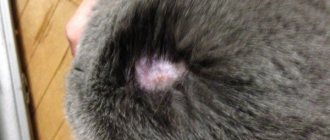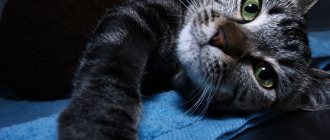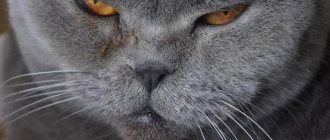Cats are distinguished by their ability to see in the dark. This is not surprising, because mustachioed pets are predators by nature. Unfortunately, eye pathologies are common in these pets. Certain eye diseases in cats lead to partial loss of vision or blindness. If you do not sound the alarm in time and contact a veterinarian, the animal may lose the ability to see. One of the main symptoms of this condition is cloudy eyes in a cat. Below we will analyze the causes of this phenomenon, and also determine possible treatment methods.
Causes of the disease
The main causes of blurred vision in a cat include:
- Diseases of the eye cornea. It loses its shine, becomes whitish, and a bluish tint appears.
- Diseases of the lens. Such pathologies are characterized by clouding of the pupil, the cornea remains transparent and is not affected. When the light is pointed at the organ of vision, the haze narrows. This confirms that the reason lies precisely in the pupil.
Below we will look at the origin of the loss of transparency of the animal's eye in more detail.
Characteristic symptoms
Doctors distinguish several degrees of damage to the organ of vision:
- peripheral (a border is observed at the edges of the eyeball);
- central (clouding of the eye is noted in the very center);
- total (the cat’s organ of vision is completely closed).
In most cases, if a kitten has a cloudy eye, there will be accompanying symptoms.
Against the background of decreased vision, the pet begins to walk unsteadily and does not notice obstacles . He becomes irritable and overly excitable. Strabismus, pain, swelling, and the appearance of discharge are possible.
If the cornea is affected, there is clouding of the surface of the eye. It acquires a blue or white tint and loses its shine.
Sometimes the lens is affected, but the cornea continues to remain transparent, and only the pupil becomes cloudy. Under the influence of bright light, a narrowing of the turbidity is observed, and when exposed to dim light, it expands.
Keratitis
With this disease, vision always becomes worse, sometimes completely lost. The disease appears due to toxic damage to the liver. Most often this occurs during intoxication and poisoning, during acute infectious pathologies of the organs of vision caused by pathogenic microorganisms, fungi, viruses or neurogenic diseases.
To stop your cat's vision loss, immediate veterinary attention is needed.
Symptoms
The first sign of keratitis is a cloudy red eye in a cat. Initially, redness and discharge of purulent or serous fluid appear. Then the cornea loses transparency, the eye becomes cloudy, and ulcers or tissue necrosis appear.
An accurate diagnosis is necessary to select the appropriate treatment. It is carried out using a special fluorescent liquid composition. After this, damage to the cornea becomes visible in the light. This type of diagnosis is carried out only in a veterinary clinic.
Treatment of keratitis
Treatment at home is strictly contraindicated. Keratitis is a polyetiological disease; without establishing the exact cause, self-therapy can be harmful.
After diagnostics and diagnosis, the specialist prescribes treatment aimed at eliminating the consequences of the identified eye pathology and maintaining the cat’s immunity.
Antiseptic drugs for washing the organ of vision, as well as antiviral and antibacterial ointments and drops, are necessarily prescribed. In addition, you should pay attention to your pet’s diet. It must be complete and contain a sufficient amount of microelements and vitamins.
Glaucoma
This eye disease in animals develops against the background of increased intraocular pressure. During an acute attack of pathology, the cornea ceases to be transparent, and the symptom of a cloudy eye appears in a cat.
Optic atrophy can cause a pet to completely lose vision within two to four days. Therefore, the cat needs emergency veterinary care.
Diagnostics
To choose the right treatment, it is necessary to make an accurate diagnosis. To do this, the following diagnostic measures are carried out:
- Schirmer's test. During the procedure, special paper is used. It is applied to the corner of the organ and the degree of wetting is observed. In this way, it is possible to determine the level of tear fluid.
- Use of ultraviolet lamps. The technique makes it possible to identify erosions and ulcers.
- Tonometry. By measuring intraocular pressure, it is possible to detect glaucoma already at the initial stage of development.
- Complete serological blood test. The study is carried out to identify infections.
- Activities aimed at identifying leukemia, toxoplasmosis, infectious peritonitis, immunodeficiency.
Additionally, the following studies are performed:
- corneal scraping;
- serology;
- Ultrasound;
- vitreous sample;
- tests to determine sensitivity to medications;
- detection of herpesvirus;
- electroretinography.
Corneal ulcers and erosions
These corneal diseases vary in depth and can occur due to chemical, thermal and mechanical injuries, as well as chlamydia, glaucoma, inflammatory eye pathologies and other diseases. The distinctive features of this disease are:
- redness of the cornea of the organ of vision;
- fear of light;
- clouding of the eye.
The owner in this situation may notice that the cat’s one eye has become cloudy, while the other is fine.
Scar (thorn) of the cornea
This defect causes clouding of the cornea after burns, trauma or ulcers. There are several types of disease:
- A peripheral cataract, it does not have a significant harmful effect on vision, since it is located away from the pupil.
- A total cataract covers the cornea and pupil. With this pathology, vision is significantly reduced.
- Central thorn. Located on the pupil itself. It can cover it completely or partially. Vision becomes limited.
The disease is characterized by a cloudy spot on the cat's eye. For treatment, special ointments and drops are used, which can only be prescribed by a veterinarian.
What to do
Treatment will depend on the underlying cause and severity of the condition.
Corneal ulcers and keratitis are usually treated with antibiotics and/or pain-relieving eye drops and ointments. Antibiotic treatment may be given several times a day. Drops or ointments for pain relief are usually prescribed less frequently, every twelve to forty-eight hours. If the keratitis is caused by the feline herpes virus, treatment may be more invasive.
Cataracts, although irreversible, can be managed by treating a secondary cause of the condition, such as high blood pressure or diabetes. Cataracts are often corrected through surgery, which is successful in most cases. This surgery involves cataract removal and synthetic lens implantation.
There is no cure for glaucoma; Treatment is palliative, or done to relieve the cat's pain rather than to treat the underlying disease. Your veterinarian may prescribe steroids and special eye drops to reduce inflammation and pressure. This may slow the progression of vision loss.
Your veterinarian will be able to advise you on a treatment and recovery plan—or refer you to an ophthalmologist—depending on your cat's needs.
Causes of clouding and damage to the lens
The pupil of the eye itself does not lose transparency, since it is a hole in the iris. The transparent biolens of the organ of vision, called the lens, becomes cloudy. It is located behind the pupil.
The main cause of clouding is considered to be cataracts. This pathology manifests itself for several reasons:
- changes in metabolism associated with the age of the animal (old individuals);
- endocrine diseases - lipid metabolism disorders, diabetes mellitus;
- pupil injuries;
- infectious pathologies in a pregnant individual can cause pathology of the eye lens in a kitten;
- Certain breeds of cats have a genetic predisposition to this disease: Persians, Burmese, Siamese.
Treatment of cataracts, carried out with the help of medications, can only temporarily slow down the development of the disease.
Stages of cataract development
- Initial . Cloudiness occurs at the edges of the eye. The cat is able to see objects and the environment around itself, but not quite clearly.
- Immature . The middle zone of the lens gradually becomes cloudy. The animal still distinguishes objects around it, but its vision drops quite significantly.
- Mature . The entire surface of the lens becomes cloudy. As a result, the cat is unable to distinguish objects or navigate in an unfamiliar room.
- Overripe . The cat completely stops seeing. She does not distinguish whether it is dark or light around her. The lens is completely destroyed. It breaks down into fibers.
The sooner you contact a good veterinary clinic in Moscow, the greater the chance of returning your cat to full vision!
Therapy
Radical treatment for lens opacity involves replacing it with surgery. If radical treatment is not carried out in time, the process will develop further with severe complications:
- uveitis – inflammation of the uvea of the eye, often leading to blindness;
- secondary glaucoma with optic nerve atrophy and vision loss;
- panophthalmitis - the release of masses of the lens into the chambers of the eye, the appearance of inflammation, pus: all this leads to the death of the eye.
It becomes clear that if a cat's eye is covered with a cloudy film, this can lead to partial loss of vision or complete blindness. Restoring the function of the organ of vision depends on how quickly the animal owner contacted the veterinarian. In addition, a correct diagnosis and quality treatment are important. Positive results most often appear in cases where the pathology is detected at an early stage of development.
Cloudy eye in a cat: signs
If a cat's eye is cloudy, then at first glance he appears to be blind. However, this is not always the case. There is only one sign of cloudy eyes in an animal – a white veil.
A cat's eye can become cloudy for a variety of reasons.
But over time, other symptoms may appear, for example:
- Blepharospasm and photophobia.
- Swelling of the conjunctiva.
- Irritability.
- Protrusion of the eye from the socket.
- Enlargement of the eyeball.
- Dilatation of blood vessels in the eye.
- The presence of purulent or mucous discharge from the eyes.
- Sleep disturbance.
- Loss of appetite.
You should not wait for signs of complications to appear, and if you notice clouding of the eye, you should immediately contact a veterinarian.
Prevention
In order to prevent clouding of your cat’s eyes, you should follow a few simple rules for keeping your pet:
- Vaccinate the animal against infectious pathologies in a timely manner;
- undergo timely examinations by a specialist;
- Consult a doctor immediately after identifying unpleasant eye pathologies.
It should be borne in mind that if the cat already has inflammation of the organs of vision, the animal must be closely monitored. Your pet should be examined at least twice a day. If severe inflammation, redness, or clouding of the cornea appears, you should immediately go to the veterinarian. To prevent the condition from worsening, all stress factors for the animal should be kept to a minimum. Since they are the ones who can provoke a deterioration in the animal’s condition. The owner must also take into account the fact that from the room where the sick cat is located, it is necessary to remove interior items that the cat could hit and suffer.
It should also be understood that any eye pathology can lead to loss of vision in a cat, so you should not leave even the most harmless inflammation of the mucous membrane uncontrolled.
In addition, the owner must provide the sick animal with complete rest and, if possible, include foods with a high concentration of tocopherol and retinol in the cat’s diet. These vitamins have a positive effect on damaged epithelial layers of the cornea and restore the organs of vision.











